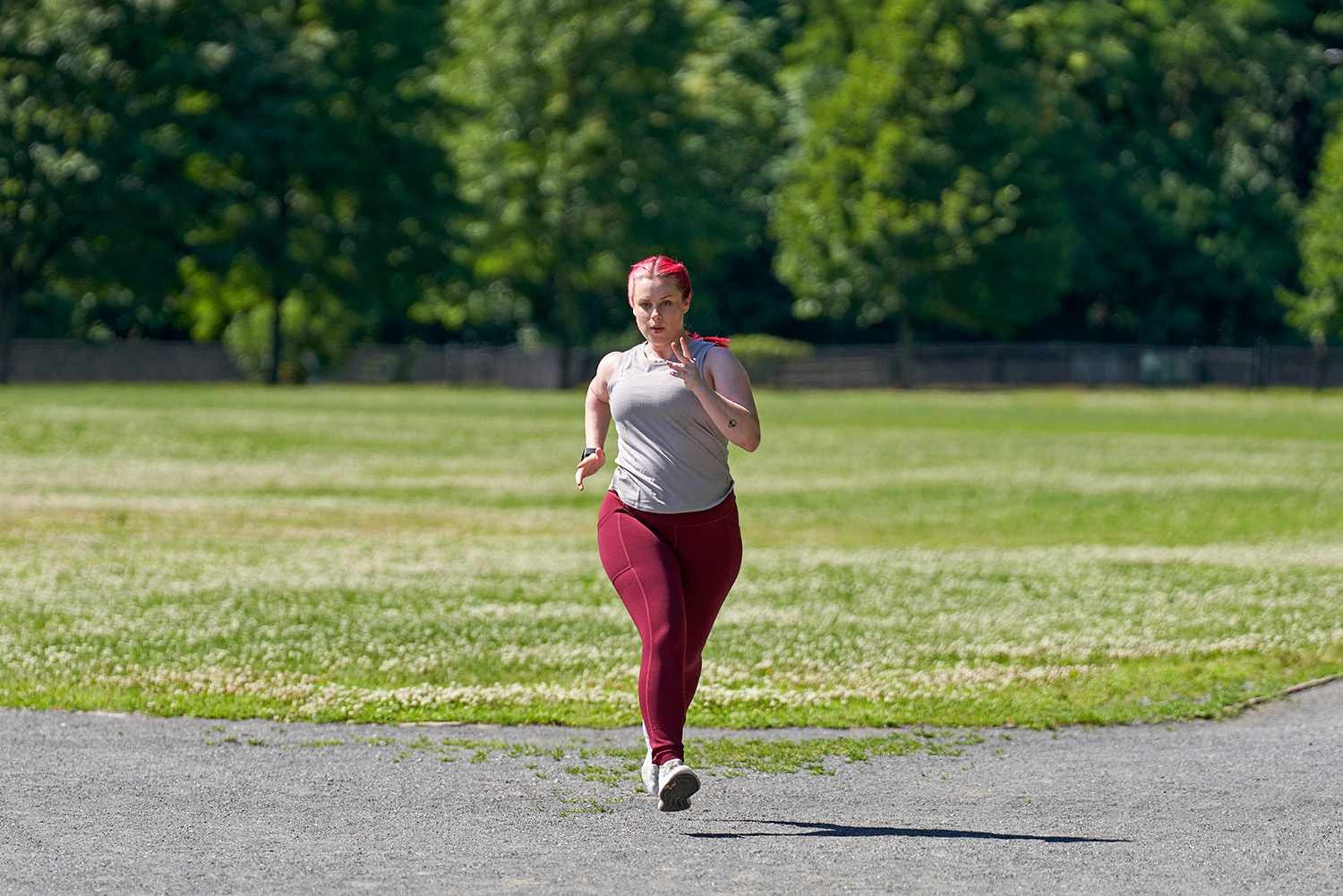

Featured
What Is Aerobic Running Pace
Published: October 5, 2023
Find out the importance of aerobic running pace and how it can improve your fitness. Get tips and guidance on setting your own pace, featured in this informative guide.
Introduction
Aerobic running pace is a fundamental concept in the world of running that plays a crucial role in improving endurance and overall performance. Whether you are a professional athlete or a recreational runner, understanding and implementing the right aerobic running pace can significantly impact your training and achieve your goals.
Aerobic running, also known as steady-state running or long-distance running, refers to a type of exercise that focuses on maintaining a moderate intensity for an extended period. This pace allows your body to utilize oxygen efficiently to meet the energy demands of running. By consistently training at an aerobic pace, you can enhance your body’s ability to utilize oxygen, improve cardiovascular fitness, and increase your endurance levels.
The importance of aerobic running pace lies in its ability to build a solid aerobic base, which serves as the foundation for higher-intensity workouts. It allows your body to adapt and become more efficient at utilizing oxygen, enabling you to sustain longer durations of physical activity without fatigue. This is particularly beneficial for long-distance runners and endurance athletes who need to perform at a high level for extended periods of time.
Several factors can influence your aerobic running pace, including age, fitness level, running experience, and individual body composition. Determining your ideal aerobic pace is important to ensure that you are training at the right intensity to achieve optimal results. By using specific methods such as heart rate zones, lactate threshold testing, or using perceived exertion scales, you can accurately gauge and maintain your aerobic running pace.
Training at an aerobic pace offers numerous benefits beyond improving endurance. It helps to strengthen your cardiovascular system, increase the efficiency of your muscles, reduce the risk of injury, and promote overall well-being. Additionally, maintaining a steady aerobic pace can enhance your ability to burn fat as a source of fuel, leading to weight loss and improved body composition.
In this article, we will explore in detail the definition of aerobic running pace, the factors that influence it, and how to determine your ideal aerobic pace. We will also discuss the benefits of training at the aerobic pace and share some tips to improve your aerobic running pace. By the end, you will have a solid understanding of why aerobic pace is essential for runners and how incorporating it into your training routine can take your running performance to new heights.
Definition of Aerobic Running Pace
Aerobic running pace is a term used to describe the intensity at which you should maintain your running effort to primarily utilize oxygen as the main source of energy. It is often referred to as the “comfortable” pace at which you can sustain a conversation while running.
At this pace, your heart rate is elevated, but not to the point where you feel breathless or excessively fatigued. It is a moderate intensity that allows your body to efficiently deliver oxygen to your working muscles, ensuring they have enough energy to keep going.
Typically, aerobic running pace corresponds to about 60-80% of your maximum heart rate. This range can vary depending on your individual fitness level and running experience. For beginners, it may be closer to the lower end of the range, while more experienced runners may be able to maintain a slightly higher intensity.
One way to determine your aerobic running pace is through the use of heart rate zones. By calculating your maximum heart rate (220 minus your age) and then finding the corresponding percentage for the aerobic zone, you can establish a target heart rate range to stay within during aerobic runs.
Another method to gauge your aerobic running pace is by using perceived exertion scales. These scales rate your effort on a scale from one to ten, with one being very light exertion and ten being maximal effort. The aerobic pace falls within the range of about 5-7 on the scale.
It is important to note that aerobic running pace is relative to your individual fitness level and may differ from someone else’s pace. It is not about comparing yourself to others, but rather finding the right intensity for you to challenge yourself and improve over time.
By maintaining an appropriate aerobic running pace, you will train your aerobic system, strengthen your cardiovascular fitness, and condition your body to efficiently utilize oxygen. This will ultimately translate into improved endurance and performance in your running endeavors.
Importance of Aerobic Running Pace
The importance of aerobic running pace cannot be overstated when it comes to achieving optimal running performance and building endurance. Here are several key reasons why aerobic running pace should be an essential part of your training regimen:
- Building a solid aerobic base: Training at the right intensity helps to develop a strong foundation in your aerobic system, which is crucial for endurance activities. By consistently running at an aerobic pace, you improve your body’s ability to efficiently transport oxygen to your muscles, allowing you to sustain longer durations of physical activity without fatigue.
- Improving cardiovascular fitness: Aerobic running engages your cardiovascular system, strengthening your heart and lungs. Over time, this leads to increased stroke volume, where your heart pumps more blood with each beat, and enhanced oxygen uptake capacity, leading to improved endurance and overall cardiovascular fitness.
- Enhancing fat-burning capacity: Running at an aerobic pace activates the utilization of stored fat as a source of fuel. This is beneficial for those seeking to lose weight or improve body composition, as it helps to burn excess fat while preserving muscle mass.
- Reducing the risk of injury: Training primarily at an aerobic pace puts less stress on your joints and muscles compared to high-intensity workouts. This lower impact reduces the risk of overuse injuries, allowing for consistent and injury-free training.
- Increasing endurance: Endurance is the ability to sustain physical effort over an extended period. By working on your aerobic capacity, you improve your endurance levels, enabling you to perform better in long-distance races, endurance events, and other activities that require prolonged effort.
- Setting a sustainable pace: Aerobic running pace is characterized by the ability to maintain a conversation while running. This ensures that you are running at a pace that is both challenging yet comfortable enough to sustain long-term, preventing early burnout or exhaustion.
Incorporating aerobic running pace into your training plan is essential for runners of all levels. It allows you to lay a strong foundation, improve cardiovascular fitness, enhance fat-burning capacity, reduce the risk of injury, and increase endurance. By understanding the importance of training at the right intensity, you can optimize your running performance and reach your goals effectively.
Factors Affecting Aerobic Running Pace
Several factors can influence your aerobic running pace. Understanding these factors can help you determine and adjust your pace to optimize your training and performance. Here are some key factors to consider:
- Fitness Level: Your current fitness level plays a significant role in determining your aerobic running pace. Beginners may need to start at a slower pace and gradually increase their intensity as they build fitness and endurance. On the other hand, experienced runners may be able to maintain a higher intensity.
- Age: Age can impact your aerobic running pace. Generally, as you age, your maximum heart rate decreases, which affects your optimal aerobic zone. It is essential to adjust your pace accordingly to ensure you’re working at the right intensity for your age.
- Running Experience: The more experience you have as a runner, the better you become at finding your optimal aerobic running pace. As you become more familiar with your body’s responses to different intensities, you can fine-tune your pace to achieve maximum efficiency.
- Individual Body Composition: Body composition, including factors such as height, weight, and muscle mass, can influence your aerobic running pace. Larger individuals may require more effort to maintain a certain pace, while lighter individuals may be able to sustain a faster pace more comfortably.
- Environmental Conditions: Factors such as temperature, humidity, and altitude can affect your aerobic running pace. Higher temperatures and humidity levels can increase the perceived exertion, making it harder to maintain your usual pace. Additionally, running at higher altitudes where there is less oxygen can also impact your pace.
- Overall Health and Well-being: Your overall health, including factors such as sleep quality, stress levels, nutrition, and hydration, can impact your aerobic running pace. Ensuring you are adequately rested, properly nourished, and hydrated will contribute to better performance and energy levels during your runs.
It’s important to acknowledge that these factors are unique to each individual. Therefore, it is essential to listen to your body and adjust your pace accordingly. Pay attention to how you feel during your runs, monitor your heart rate if using a monitor, and regularly reassess and adjust your training plan as needed.
By understanding and accounting for these factors, you can find your optimal aerobic running pace, ensuring that you are training at the right intensity to improve your endurance, performance, and overall running experience.
How to Determine Your Aerobic Running Pace
Determining your aerobic running pace is crucial to ensure that you are training at the right intensity to maximize the benefits of your workouts. Here are several methods you can use to determine your aerobic running pace:
- Heart Rate Zones: One common method for determining your aerobic running pace is by using heart rate zones. To calculate your maximum heart rate, subtract your age from 220. Your aerobic running zone typically falls within 60-80% of your maximum heart rate. You can use a heart rate monitor during your runs to ensure you stay within this target range.
- Lactate Threshold Testing: Lactate threshold testing involves measuring the point at which lactic acid starts to accumulate in your muscles. This point is an indicator of the intensity at which your body shifts from primarily aerobic to anaerobic energy production. By performing a lactate threshold test, you can determine your aerobic running pace by staying below your lactate threshold heart rate or pace.
- Perceived Exertion: Using perceived exertion scales is another effective way to gauge your aerobic running pace. This method relies on assigning a rating of perceived exertion (RPE) to your running effort, typically on a scale from one to ten. During aerobic runs, aim for an RPE of around 5-7, where you feel moderately challenged but still able to maintain a conversation.
- Talk Test: The talk test is a simple yet effective way to determine your aerobic running pace. If you can comfortably hold a conversation while running without feeling breathless or experiencing extreme fatigue, you are likely within your aerobic zone.
It is important to note that these methods are not mutually exclusive, and you may choose to use a combination of them to determine your ideal aerobic running pace. Additionally, it is essential to periodically reassess and adjust your pace based on improvements in your fitness level or changes in your health status.
Remember that determining your aerobic running pace is a process that requires some trial and error. Be patient and listen to your body’s signals. Over time, you will become more attuned to finding the right pace that allows you to train effectively and enjoy your runs.
By accurately determining your aerobic running pace, you can optimize your training efforts, improve your endurance, and achieve better overall running performance.
Benefits of Training at Aerobic Running Pace
Training at your aerobic running pace offers numerous benefits that can significantly impact your overall fitness and running performance. Here are several key advantages of incorporating aerobic training into your running routine:
- Improved Endurance: Aerobic running is essential for building endurance. By training at this pace, you strengthen your cardiovascular system, improve oxygen utilization in your muscles, and enhance your body’s ability to sustain physical activity for longer durations.
- Increased Fat Burning: Running at an aerobic pace encourages your body to use fat as a primary source of energy. This is particularly beneficial for those looking to lose weight or improve body composition, as it helps to burn stored body fat while preserving muscle mass.
- Enhanced Cardiovascular Fitness: Aerobic training strengthens your heart and improves overall cardiovascular fitness. Regular aerobic runs help increase stroke volume, which is the amount of blood pumped with each heartbeat, and improve the efficiency of your heart’s ability to deliver oxygenated blood to your muscles.
- Reduced Risk of Injury: Training primarily at an aerobic pace reduces the impact on your joints and muscles, lowering the risk of overuse injuries. It allows for a more sustainable and balanced approach to training, reducing the strain on your body and promoting a healthy and injury-free running experience.
- Mental and Emotional Benefits: Aerobic running releases endorphins, the feel-good hormones, which can improve your mood and alleviate stress. Regular aerobic training can boost mental clarity, reduce anxiety, and enhance overall well-being.
- Building Foundations for Higher Intensity Workouts: Working at your aerobic running pace helps develop a strong foundation that can support higher intensity workouts in the future. It allows you to gradually and safely progress to more challenging training sessions without compromising your overall fitness.
- Improved Recovery: Aerobic training stimulates blood flow, aiding in the removal of waste products from your muscles and promoting faster recovery. It also helps to increase the delivery of oxygen and nutrients to your muscles, facilitating their repair and growth.
It is worth noting that the benefits of training at your aerobic running pace are cumulative and become more pronounced over time. Consistency is key to maximizing these advantages and reaping the long-term benefits of aerobic training.
By incorporating regular aerobic runs into your training program, you enhance your endurance, increase fat burning, improve cardiovascular fitness, reduce the risk of injury, experience mental and emotional benefits, build a foundation for higher intensity workouts, and aid in recovery. These benefits contribute to improving your overall running performance and enhancing your overall well-being.
Tips for Improving Aerobic Running Pace
1. Gradually Increase Distance and Duration: Increase your running distance and duration gradually to build your aerobic capacity. Start by adding a few extra minutes or miles to your runs each week to allow your body to adapt to the increased demands.
2. Incorporate Interval Training: Interval training involves alternating between periods of higher intensity and periods of recovery. By incorporating short bursts of faster running or sprints into your aerobic runs, you can challenge your aerobic system and improve your overall running pace.
3. Mix Up Your Training Terrain: Running on different terrains can help improve your aerobic running pace. Try incorporating hill workouts, trail runs, or sand runs to work different muscles and enhance your overall endurance.
4. Focus on Proper Breathing Techniques: Efficient breathing is crucial for maintaining an optimal aerobic running pace. Practice diaphragmatic breathing, inhaling deeply into your belly and exhaling fully, to ensure adequate oxygen intake and minimize fatigue.
5. Cross-Train: Engaging in other forms of aerobic cross-training, such as cycling, swimming, or using an elliptical machine, can help improve your aerobic fitness while giving your running muscles a break. This can contribute to better overall endurance and a faster aerobic running pace.
6. Maintain a Balanced Training Plan: It’s important to balance your aerobic runs with other types of workouts, such as strength training and flexibility exercises. Strengthening your muscles and improving your overall mobility can complement your aerobic training and contribute to better running pace.
7. Monitor and Adjust Intensity: Regularly check your heart rate or use perceived exertion scales to ensure you are training within your desired aerobic zone. If you find your pace is becoming too easy, consider increasing your intensity to continue challenging your aerobic capacity.
8. Prioritize Rest and Recovery: Adequate rest and recovery are crucial for improving your aerobic running pace. Include rest days in your training schedule to allow your body to recover and rebuild, preventing overtraining and reducing the risk of injury.
9. Consider Professional Guidance: If you’re looking to make significant improvements in your aerobic running pace, working with a running coach or a certified fitness professional can provide personalized guidance and help develop a training plan tailored to your goals and abilities.
10. Stay Consistent: Consistency is key when it comes to improving your aerobic running pace. Make aerobic training a regular part of your routine to see gradual and sustainable improvements over time.
By implementing these tips into your training regimen, you can effectively improve your aerobic running pace, enhance your endurance, and unlock your full running potential.
Conclusion
Aerobic running pace is a fundamental aspect of training for runners of all levels. By understanding and implementing the right aerobic pace, you can significantly improve your endurance, cardiovascular fitness, fat-burning capacity, and overall running performance.
Throughout this article, we have explored the definition of aerobic running pace, the factors that can affect it, and how to determine your optimal pace. We have also discussed the importance of training at the right intensity and the numerous benefits that come with incorporating regular aerobic runs into your training plan.
Whether you are a beginner or an experienced runner, finding and maintaining your ideal aerobic running pace should be a priority. It allows you to build a solid foundation, improve cardiovascular fitness, reduce the risk of injury, and increase your endurance levels. Aerobic training also promotes mental and emotional well-being, making it a holistic approach to overall fitness.
Remember, consistency is key when it comes to reaping the benefits of aerobic running pace. Gradually increase your distance and duration, incorporate interval training, focus on proper breathing techniques, and maintain a balanced training plan. Monitor your intensity, prioritize rest and recovery, and seek professional guidance when needed. By following these tips, you can continuously improve your aerobic running pace and achieve your running goals.
So lace up your running shoes, find your optimal pace, and embrace the power of aerobic training. Whether you’re aiming for a personal best time or simply want to enjoy the pure joy of running, training at your aerobic running pace is the key to unlocking your full potential as a runner.








